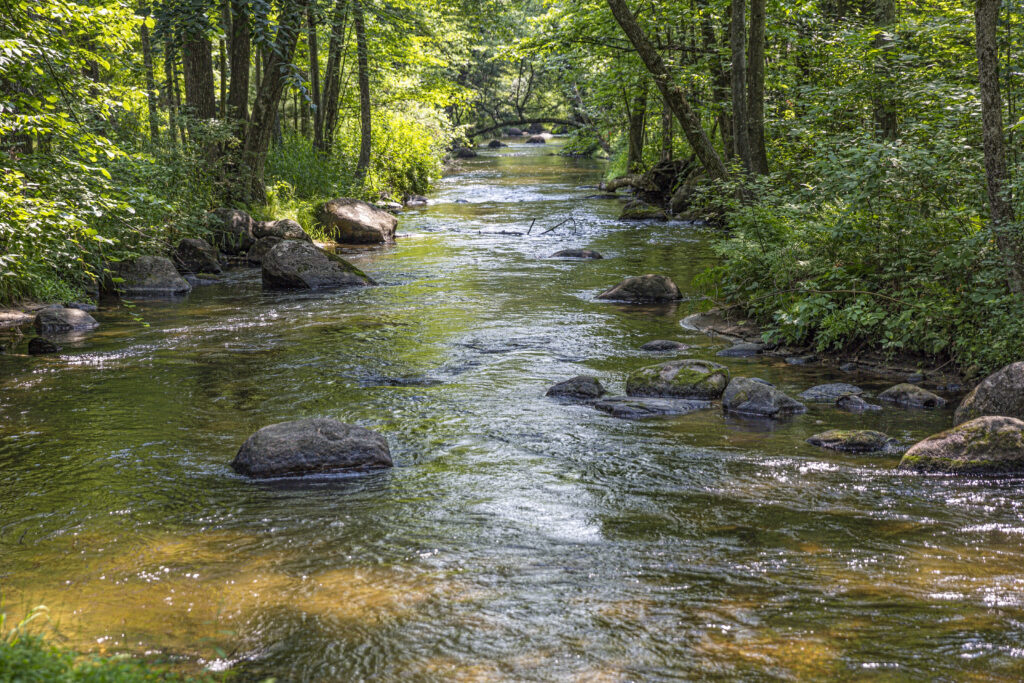“Mitigation banking” is a system designed to compensate for environmental losses caused by land development. It involves creating, restoring, enhancing, and preserving natural habitats such as wetlands and streams. This system ensures high-quality environmental offsets as validated by the Ecological Restoration Business Association (ERBA).
According to Investopedia, in July 2021, there were over 2,000 approved mitigation banks in the U.S. This can be confirmed on the United States Army Corps of Engineers Regulatory In-lieu Fee and Bank Information Tracking System (RIBITS) website where the count of approved mitigation banks as of 8/27/2024 is over 2,600 approved mitigation banks. The practice continues to grow, providing an effective means for environmental compensation.

Why Are Stream Mitigation Banks Necessary?
There are relatively new regulations in Minnesota and Wisconsin (coming soon in other Midwest states) that require landowners and developers to mitigate their impacts on existing streams.
Just like existing wetland mitigation regulations and requirements, these projects must be completed to a very high standard, at which point they can generate sellable credits on an open market. These projects are protected by a permanent conservation easement and will provide habitat and environmental benefits for future generations.
Mitigation banking serves several pivotal roles:
- Offsetting ecological losses from development projects.
- Mainly focusing on wetlands, streams, and habitats of endangered species.
- Protecting nature and mitigating harmful impacts of industrial growth.
- Allowing developers to buy credits to offset ecological damages makes it a cost-effective high quality solution.
Developers buy credits to offset their projects’ ecological footprints. This systematic approach provides an efficient, market-based system that assigns sorely needed financial worth to complex functions like flood control, water quality protection, and wildlife habitat.
How Does Mitigation Banking Work?
There are two main types of mitigation banks:
- Wetland or Stream Mitigation Banks are regulated by the U.S. Army Corps of Engineers (USACE) and the U.S. Environmental Protection Agency (EPA).
- Conservation Banks, which focus on endangered species and their habitats and are regulated by the U.S. Fish and Wildlife Services and the National Marine Fisheries Service.
The process for creating a mitigation bank can be simplified as follows:
- Collaboration with regulatory teams (MBRT and CBRT) for approval and monitoring.
- Construction of the mitigation bank project.
- Establishing mitigation credits for restoration efforts.
- Developers buy these credits to offset project impacts.
What are the Benefits of Mitigation Banking?
The concept of mitigation banking provides many advantages that make it a valuable strategy for both developers and the environment.
Environmental Protection
A principal benefit is its role in environmental protection. Mitigation banking helps counteract the environmental impacts of industrialization and urbanization. This not only conserves biodiversity but also ensures that ecosystems continue to function efficiently.
Project Efficiency
Efficiency is another significant advantage. Restoring a vast, consolidated piece of land is generally more cost-effective and productive than attempting to rehabilitate numerous small plots. Mitigation banks harness economies of scale and technical expertise, yielding higher-quality restored acreage for a fraction of the effort involved in piecemeal restoration projects.
Simplified Process
Time efficiency and regulatory ease are also crucial benefits. Navigating regulatory approvals can be a cumbersome process for developers. Mitigation banks, however, simplify this maze. Because these banks have already restored units of affected acreage, there is a minimal lag between the environmental impact at a service area and its restoration at a bank site. Developers can enjoy expedited projects without compromising compliance.
Transfer of Liability
One of the most compelling benefits of mitigation banking is the transfer of liability. This system effectively shifts the responsibility for ecological loss from the developer to the mitigation banker. Once developers purchase the required credits, as mandated by regulations, the onus of developing, maintaining, and monitoring the site rests with the mitigation banker.
This not only ensures consistent oversight but also allows developers to focus on their core projects without being bogged down by environmental concerns.
What are the Challenges of Mitigation Banking?
However, mitigation banking is not without its challenges. One of the foremost hurdles is the difficulty in assigning a monetary value to ecological losses. While regulatory agencies employ various environmental assessment techniques, accurately capturing the economic impact of damage to natural resources remains elusive.
Artificial restoration poses another significant challenge. Natural habitats and wetlands take centuries to evolve, and replicating them artificially within a few years can often result in sub-standard outcomes, especially in terms of floral and faunal diversity. Mitigation banks sometimes struggle to fully replicate the intricate ecosystems that they aim to restore.
Additionally, the geographic disparity between impact sites and mitigation banks can be problematic. Typically, mitigation banks are situated far from the sites where ecological impacts occur, limiting their ability to fully mimic the conditions and characteristics of the affected areas. This spatial disconnection can undermine the effectiveness of the mitigation efforts.
Find a Trusted Partner to Help
At Midwest Wetland Improvements, we have deep experience in mitigation banking and can help you identify credit availability, credit purchase, compliance assurance, project design, regulatory permitting, project approval, construction bidding and oversight, and restoration and monitoring.
Let us help you navigate the complexities of mitigation banking. Contact us today to discuss!


Recent Comments